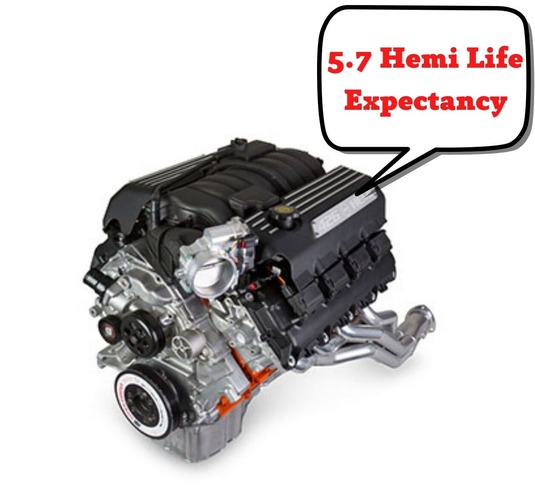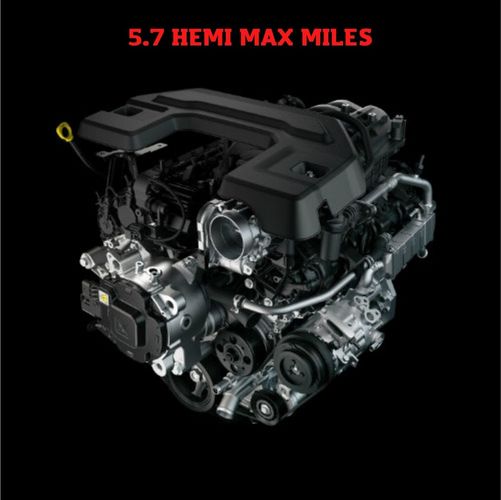
Engine life expectancy is an important factor in deciding what car to buy. For obvious reasons such as the longevity of the vehicle's lifespan and optimal functionality, prospective car buyers and owners often inquire, "how many miles can the engine last?"
This article highlights the life expectancy for the 5.7 Hemi engine. It further discusses how many miles the 5.7 Hemi engine can last and factors that may reduce the longevity of its life.
In the end, you will know:
- The nature of the Hemi engine design
- How many miles it can last
- The common problems with the Hemi 5.7
- Some engine maintenance tips to increase its lifespan
So, let's get started!
The Hemi 5.7 Engine
Chrysler presented the Hemi 5.7 in 2003 with its 2003 Dodge Ram Trucks. It was released as a 5.7-Litre V8 gasoline engine. It is a patented work of Chrysler, even though many other car manufacturers have adopted the design of the Hemi 5.7 engine.
The Hemi 5.7 engine is also sometimes called the 345 Hemi. Apparently due to its original power of 345 hp. Unlike flat piston engines, it offers a higher rate of compression, which gives more energy. Proof of this is its debut of 345 horsepower in the 2003 Dodge Ram.
The Design of the 5.7 Hemi engine
Originally, it was built with a cylinder block made of cast iron and was designed with a right angle between cylinder banks.
The crankshaft is built with cast iron. Four bolts brace it for each principal bearing. It utilizes light aluminum pistons.
Until 2009, the rings of the pistons were 1.50/1.50/3.0 mm wide. But in 2009, remodeling was undertaken, and the pistons were remodeled to have narrower rings measuring 1.20/1.20/2.0 mm. Between the cylinder banks is the location of the chain-driven camshaft.
It has cross-flow cylinder heads that are made of aluminum with two sparks for each cylinder and two valves.
For efficiency and reduction of emissions, the chambers have been remodeled to have a level construction with loose shelves on either side. The Hemi 5.7 also has beehive valve spring fits. The Hemi 5.7 is also furnished with hydraulic roller lifters.
Its intricate design has a system called the Multiple Displacement System, which is charged with reducing fuel burn and carbon emissions. It does this by regulating the stream of oil from the lifters of matching valves, thereby keeping the intake and exhaust valves closed. It also turns off the fuel in four cylinders to accomplish this control.
Chrysler made some significant modifications to the design of the Hemi 5.7L in 2009. The ultimate goal was to increase stability and efficiency. One of the major changes was the inclusion of the Variable Valve Timing. This necessitated the addition of three oil corridors and a front camshaft connecting in the block.
Before 2009, the engine block featured a cast-iron crankshaft for durability. The engine came with a reinforced connecting rod, dual-mass crankshafts, and state-of-the-art pistons for narrower ring packs. But since 2009, new models have come with the active intake. This is an electronically monitored varying stretch of the admission runner.
Also, the cylinders have been significantly modified. Major modifications include:
- Larger and slightly quadrilateral intake ports stream 14% extra air than prior elongated ones.
- Exhaust channels that come with a lifted cover and are shaped like a “D”.
- A 2mm increase in the size of the intake valve.
- A deviation from the 85cc original round chambers to the new 65cc oval chambers.
The results include increased efficiency and an increase in compression ratio to 10.5:1.
Because of its efficiency and impressive productivity, Chrysler stopped the production of other models of the Hemi engines, such as the 4.7L V8 PowerTech. Only the 5.7L Hemi engine was continued, and it became the base V8 option.
The 5.7 Hemi is more expensive compared to its market peers for the obvious reasons of its intricate design and precision.
How Many Miles Will The Engine Last?

The 5.7 Hemi engine can run from 250,000 to 300,000 miles optimally. After getting up to 250,000 miles, you may expect a gradual decline in your engine performance.
However, some varying factors may also affect the lifespan of your 5.7 Hemi engine and cause an early decline in its performance before it has lasted up to 250,000 miles. These factors include the following:
- Rough terrains
- Poor maintenance routine
- Harsh environmental conditions
Some Common Hemi 5.7 Engine Problems
Although the life expectancy of the Hemi 5.7 engine is between 250,000 to 300,000 miles, some common problems of the engine may minimize that lifespan. These include the following issues.
Camshafts and Lifter Failure
The camshaft regulates the intake of fuel, and the displacement of exhaust smokes. It comprises numerous radial cams, each displacing input or exhaust valves.
It is linked to the crankshaft by a belt, chain, or gears. This is to ensure the uniform timing of the valves in connection with the movement of the pistons.
Lifters failures produce a ticking noise after you have started your car. Although there have been numerous assumptions about the cause of the ticking noise that failing lifters produce, there is no technical service publication for the correction of this problem.
Common symptoms of the camshaft and lifter failure are misfiring, ticking/tapping noise, and camshafts locking up.
However, common reasons for lifter and camshaft failures include:
- Low engine oil level makes it difficult for the parts to move
- Using the wrong type of engine oil
- Excessive spring pressure
Damaged Exhaust Manifold Bolts
Before it runs its usual life expectancy period, Hemi 5.7 engines are prone to faulty exhaust manifold bolts. These bolts are used to hold the exhaust manifold in place. The exhaust manifold, on the other hand, is a unit made of either steel or cast iron with the function of collecting engine exhaust gas from all the cylinders and directing them all to the exhaust pipe.
When the exhaust manifold bolts get damaged, the engine will have problems eliminating the exhaust gas. The occasioned leak will also reduce the power and fuel economy of your vehicle.
One sure way to deduce this problem is to pay attention to the unusual sounds of your engine. You are most likely to hear the ticking sound in the engine once the problem starts.
Maintenance Tips For Your Hemi 5.7 Engine
Proper handling of your vehicle
Improper driving habits have a negative impact on the lifespan of your Hemi 5.7 engine. These habits include:
- Not halting the vehicle before shifting from reverse to drive
- Driving fast over speed bumps
- Missing gears while shifting
- Sudden braking
These bad driving habits reduce the performance as it negatively impacts your engine. It also reduces the lifespan of your engine.
Proper Tire Maintenance Routine
The performance and lifespan of your engine depend on a number of factors; key among them is the amount of energy required to move your car. A proper tire maintenance routine can increase the lifespan of your engine. This is because when you drive with low-pressure tires, your engine is forced to produce more energy to cater to the needed drag and friction to move your vehicle.
Therefore, to avoid overworking your 5.7 Hemi engine, follow your tire manufacturer's directions and PSI recommendations to keep your tires in optimal condition. This will prolong the life of your engine.
Oil Maintenance Routine
Apart from the benefit of optimal performance of your car, sticking to a regular oil maintenance schedule prolongs the life of your engine.
Your engine needs oil to rotate its part for proper functioning. However, in time, the oil gathers debris and becomes less efficient. Follow the manufacturer's guide on how often you must change your oil.
Allow your engine some air
Conditions that restrict the engine's intake of oxygen must be avoided as this will negatively impact the longevity of the engine life.
The functionality of the Hemi 5.7 engine reduces when it does not get enough oxygen. Overheating, poor fuel efficiency, and an increase in emissions are likely to occur when the engine does not take in enough oxygen.
Regular checking of the coolant levels
To ensure that your engine lasts longer, regularly check the coolant level. The aim of this maintenance routine is to prevent engine overheating.
If the coolant is no longer functional or must be replaced, ensure to replace it with an equivalent of the exact type for compatibility reasons. Using the wrong coolant may have a negative impact on the life of your Hemi 5.7 engine.
Bottom line
The 5.7 Hemi engine has a lifespan of about 250,000 to 300,000 miles. But some factors may vary the longevity of the engine life. These factors include poor engine maintenance routine, unfavorable environmental conditions, and poor vehicle handling, among others.
Regardless, it is one of the most trusted engines, so much so that other car manufacturers have begun to build engines with similar designs and principles. To get the most from your Hemi 5.7 engine, heed the tips in this article.
About the authors
The CarAraC research team is composed of seasoned auto mechanics and automotive industry professionals, including individuals with advanced degrees and certifications in their field. Our team members boast prestigious credentials, reflecting their extensive knowledge and skills. These qualifications include: IMI: Institute of the Motor Industry, ASE-Certified Master Automobile Technicians; Coventry University, Graduate of MA in Automotive Journalism; Politecnico di Torino, Italy, MS Automotive Engineering; Ss. Cyril and Methodius University in Skopje, Mechanical University in Skopje; TOC Automotive College; DHA Suffa University, Department of Mechanical Engineering






Add comment